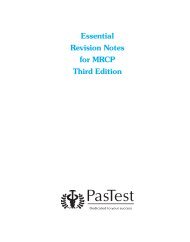MRCPCH 1: Essential Questions in Paediatrics - PasTest
MRCPCH 1: Essential Questions in Paediatrics - PasTest
MRCPCH 1: Essential Questions in Paediatrics - PasTest
- No tags were found...
You also want an ePaper? Increase the reach of your titles
YUMPU automatically turns print PDFs into web optimized ePapers that Google loves.
CARDIOLOGY – ANSWERS 7MT–F Answers1.1 Muscular ventricular septal defects (VSDs): DVentricular septal defects are the most common form of congenital heartdisease, compris<strong>in</strong>g 30% of the total number of cases. Muscular VSDs occur<strong>in</strong> the muscular part of the ventricular septum. Subacute bacterialendocarditis (SBE) prophylaxis is no longer <strong>in</strong>dicated, now only be<strong>in</strong>grequired <strong>in</strong> rare and specific cases. The pulmonary resistance is high atbirth, and hence there is little shunt between the two ventricles andtherefore no audible murmur <strong>in</strong> the first 24 hours. Only 25% of VSDsrequire cardiac surgery, and this is usually performed when the child is 3–5months of age. Very few patients have <strong>in</strong>terventional catheter closure,usually for smaller defects and at a later age. The conduction tissue islocated <strong>in</strong>feriorly <strong>in</strong> a perimembranous septal defect, which means thatsurgeons need to avoid that area when sutur<strong>in</strong>g a patch <strong>in</strong> place to closethe defect. If the VSD is large, patients present with symptoms of heartfailure after the first week of life and at that age have a right ventricularheave, a soft systolic murmur accompanied by an apical mid-diastolicmurmur, and a loud pulmonary second heart sound on exam<strong>in</strong>ation.1.2 Scimitar syndrome: B DScimitar syndrome is a form of anomalous pulmonary venous dra<strong>in</strong>age <strong>in</strong>which the ve<strong>in</strong>s from the lower right lung dra<strong>in</strong> <strong>in</strong>to the <strong>in</strong>ferior vena cava.The right lung itself is hypoplastic, and there is an associated dextrocardiadue to the heart mov<strong>in</strong>g over to the right side of the chest, but withnormal situs. Situs is the orientation of the organs, situs solitus be<strong>in</strong>gnormal, and situs <strong>in</strong>versus be<strong>in</strong>g mirror image. The arterial supply to thelung is from branches of the descend<strong>in</strong>g aorta. The right upper lobepulmonary ve<strong>in</strong> dra<strong>in</strong><strong>in</strong>g <strong>in</strong>to the <strong>in</strong>ferior vena cava may be seen as avertical l<strong>in</strong>e on a chest X-ray and is known as the ‘scimitar sign’. There maybe an atrial septal defect, and children can suffer with recurrent chest<strong>in</strong>fections, which may require right lower lobectomy.1.3 Congenital heart disease on the first day of life: D EBabies present<strong>in</strong>g with left-to-right shunt will have no murmur or symptomson the first day of life, because the pulmonary vascular resistance has yet tofall. Similarly, any common mix<strong>in</strong>g disease, such as atrioventricular septaldefect, can present with severe cyanosis on the first day of life, with highpulmonary vascular resistance, before breathlessness and heart failuredevelop at 1 week of age or more. All the obstructed left heart lesions, such
















